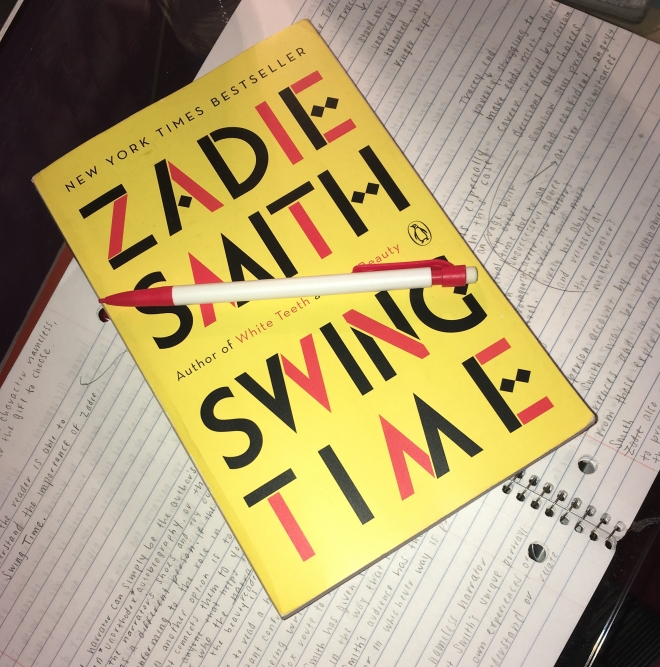
Reflecting on this English 131 class brings a monthly feature of the course to the forefront of my mind. The monthly letters were, by far, my favorite assignments throughout the course. I must admit that I haven’t written a letter to be mailed to someone since I was in elementary school. Letter writing seems to have become a lost art in our modern society, especially in the millennial generation. Even when I was mailing letters, I was too young to realize just how fulfilling it is to sit down and spend quality time writing a thoughtful letter to an important person. Our society loves digital communication because “the wonderful thing about email is its immediacy. A conversation can be had – a decision made, a plan refined – in a matter of minutes, no matter where in the world the two parties happen to be. A letter, by contrast, always arrives from the past” (McGregor). Although letters are not the speediest forms of communication, there is an undoubted sense of anticipation factored into receiving a letter. Not only is it exciting to be sent a letter, the process of writing a letter is equally as stimulating. It is truly satisfying to tuck the letter neatly into its envelope, write the appropriate information on the front, stick a stamp on the corner, and finally seal the envelope in an act of gratification. I am very thankful to have been reintroduced to writing letters. Not only was letter writing a break from the screen of a laptop or phone, but it was also an effective and meaningful way to communicate with some very special people: my dad, mom, and my roommate’s mom in Scotland.
Ever since I moved out of my home and away from my parents, communication has become a vital tool within the family dynamic. My parents, however, have never been technologically savvy and they struggle to use their cell-phones, much less communicate with me consistently through text. My dad has an especially difficult time with his device, and was extremely pleased when he received my letter in the mail. My dad has sent and received many letters because of his strong belief in handwritten communication, and I wanted to write him a letter that he would remember for years to come. The process of sitting down at my desk to write my dad’s, as well as my other recipient’s letters, was drastically different from sending a text or an email. I have always felt that writing longhand requires more thought, as well as more editing, and I found that to be completely true, if not more so, in the process of writing these letters.
My mom was also pleasantly surprised to find that I had written her a letter. Although my mom does has a love/hate relationship with her cell phone, she is more reliant on technology than my dad is. She is able to text me throughout the day, and enjoys doing so, but she found my letter to be extremely meaningful because she was not expecting to hear from me through any other form of communication besides text or the occasional call. She was so grateful that I had taken the time to write a page and a half worth of words dedicated to how thankful I was for her. It was clear that reading written words off of a page was more impactful to her than reading words off of a screen. Letters provide tangible evidence that a person cares about another person enough to cogitate words and write them down on a piece of paper for that person. I learned recently that my mom even keeps the letter in her purse to read throughout the day. That knowledge alone is enough to keep me writing letters for the rest of my life.
As important as sending letters to my parents was, sending a letter on a journey to another country took the cake. For my final letter of the semester I decided to send a letter to my roommate’s mom who I had the good fortune of spending time with over a two week period when she came here to visit. From the information my roommate has shared with me, her mom is a sentimental person who greatly appreciates any form of thoughtful gestures. I wanted to make sure I conveyed my thankfulness for the multiple restaurant trips, as well as the quality conversation she and I engaged in during her time spent here. Out of the four letters I wrote this semester, I spent the longest amount of time writing hers. Most of the writing process for the letters I wrote, especially hers, took place in my mind; I thought long and hard about the specific phrasing of the sentences in my head until I felt that the words were ready to be written down. I am eager for the letter to be sent, and I hope that she will write back so that I can carry on writing letters to her in Scotland.
Throughout the semester I looked forward to the end of the month when I would be sending a letter to a special person in my life. It was refreshing to take my time with the writing process, not worried about a deadline or format, just making the effort to write the most considerate letter I could compose. Some of my most thoughtful writing in this course has taken place in the monthly letters, and predominantly benefited my ability to think more critically about my work. Sending these written letters goes hand in hand with spending time away from the screens that have taken over the way we communicate with others. Truth be told, “the physical heft of a letter gives the communication a psychological weight that email and texts just don’t have” (McKay). I also believe that writing longhand instead of typing, invigorates my mind and allows for my writing to be very raw and truthful. It can be easy to type whatever comes fastest to mind when texting or emailing, but writing longhand encourages a more thought-provoking, and ultimately, a more meaningful writing process.
Works Cited
McGregor, Jon. “From Me, with Love: the Lost Art of Letter Writing.” The Guardian, Guardian News and Media, 26 Nov. 2016, http://www.theguardian.com/lifeandstyle/2016/nov/26/from-me-with-love-lost-art-letter-writing.
McKay, Kate. “How to Write a Letter.” The Art of Manliness, 26 Nov. 2017, www.artofmanliness.com/2017/10/27/how-to-write-a-letter/.
Annotated Bibliography
Beatty, Robert. Serafina and the Black Cloak. Disney/Hyperion, 2015.
Serafina and the Black Cloak is Robert Beatty’s young adult novel rooted in adventure and the supernatural. Set in Asheville, North Carolina and more specifically the Biltmore Estate, a young girl and her mechanic father live in the basement of the famous mansion. Serafina is the girl who must stay hidden away in the basement, never to be seen by the owners of the house, The Vanderbilts, and their guests. Serafina is not like the other girls her age; she has unusual yellow eyes, only eight toes, the ability to see well in the dark, and she is extraordinarily stealthy which comes in handy for catching the rats that scamper throughout the house. Although Serafina loves her Pa, she spends most of her time wondering where and who her mother is. One day Sera’s less than normal life becomes even more abnormal when she witnesses a girl vanish at the hands of a man in a black cloak. In the process of hunting down the cloaked man she is joined by new companions including the nephew of the Vanderbilts, Braeden, and his dog. Serafina makes it her mission to bring peace back to the Biltmore and she also learns more about herself and her origin along the way.
Collins, Billy. Snow Day. The Poetry Foundation, 2016.
In the poem, “Snow Day” by Billy Collins, the speaker describes the snowy scenery outside, as well as the different activities that will or might take place during the wintery day. The buildings and ground are covered in the snow and the speaker contemplates going outside with his dog to take in the snow, but he also enjoys looking at the snow from the inside while he drinks his hot tea and listens to the radio. On the radio the speaker hears a multitude of schools being closed and the speaker observes three girls, out in the snow due to the schools being closed, who are whispering about an unknown topic which provokes the speaker to wonder what the children are discussing.
Lewis, Michael. “Chapter One.” The Blind Side: Evolution of a Game, Norton, 2006, pp. 15–16.
In an excerpt from Chapter One of Michael Lewis’ The Blind Side, the scene of Joe Theismann’s career ending injury is set and described. Lewis depicts the event second by second, specifically using the classic phrase for measuring time in seconds, “One Mississippi”. The play begins with a handoff to the running back which turns into the “throw back special” in which the ball comes back to Theismann who then has to avoid a linebacker. He does the successfully, but Lewis writes that he is now “at the mercy of what he can’t see” which is the New York Giants’ Lawrence Taylor. Lewis turns three and a half seconds into a descriptive paragraph, painting a detailed picture of the events leading up to Theismann’s career ending injury.
Richtel, Matt. “Blogs vs. Term Papers.” The New York Times, The New York Times, 20 Jan. 2012, http://www.nytimes.com/2012/01/22/education/edlife/muscling-in-on-the-term-paper-tradition.html.
In Matt Richtel’s article “Blogs vs. Term Papers”, several professors and esteemed writers are quoted concerning their different perspectives on blog entries and term paper writing. There has been an ongoing discussion amongst writers and teachers as to which of the two is best at encouraging critical thinking and writing. Duke University’s Cathy Davidson has advocated for shorter pieces of writing in the form of blog entries, while others such as Douglas B. Reeves consider term papers to be more appropriate for higher education writing. Stanford University’s Andrea Lunsford argues that both forms of writing should be utilized at the college level, believing that term papers should have a life beyond submission for a grade. She encourages students to turn their academic papers into blog entries, as well as other forms of creative writing.
Smith, Zadie. Swing Time. Penguin Books, 2017.
In Zadie Smith’s best selling novel Swing Time, two young girls are introduced to each other through dance and build a relationship with each other that makes a lasting impact on the both of them. Swing Time presents the adolescence and adulthood of the two girls, one of which is the nameless narrator that the account is told from and the other is her friend Tracey. Multiple hardships and difficulties arise for the pair, some of which that take a serious toll on their friendship throughout their lives. The account swings back and forth in time depicting the development and derailing of the complex friendship, as well as the events that take place throughout their lives shaping them into adults.
Twenge, Jean M. “Have Smartphones Destroyed a Generation?” The Atlantic, Atlantic Media Company, 19 Mar. 2018, http://www.theatlantic.com/magazine/archive/2017/09/has-the-smartphone-destroyed-a-generation/534198/.
The article “Have Smartphones Destroyed a Generation” by Jean Twenge, focuses on a generation absorbed by smartphones and the dramatic effects that the devices have on the latest generation. Twenge refers to this generation as iGen, and although iGen has proven to be safer physically than the generations before it, the mental health state of iGen is in danger. Twenge examines a major factor of this mental health crisis, and notes that it can be traced back to smartphones and the social media that the generation has access to through smartphones.





